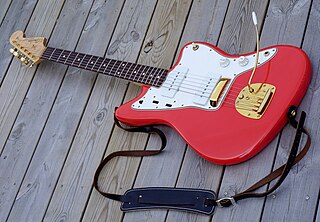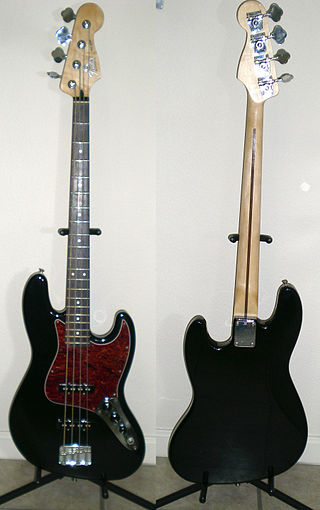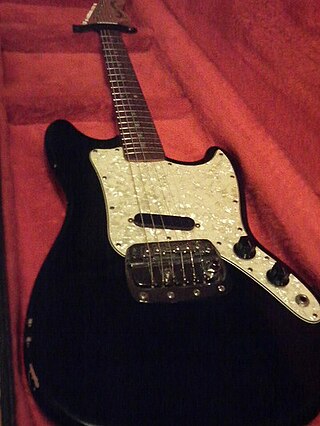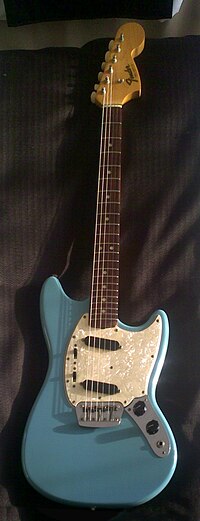
The Fender Jazzmaster is an electric guitar designed as a more expensive sibling of the Fender Stratocaster. First introduced at the 1958 NAMM Convention, it was initially marketed to jazz guitarists, but found favor among surf rock guitarists in the early 1960s. Its appearance is similar to the Jaguar, though it is tonally and physically different in many technical ways, including pickup design, scale length and controls.
The Fender Jaguar is an electric guitar by Fender Musical Instruments characterized by an offset-waist body, a relatively unusual switching system with two separate circuits for lead and rhythm, and a short-scale 24" neck. Owing some roots to the Jazzmaster, it was introduced in 1962 as Fender's feature-laden top-of-the-line model, designed to lure players from Gibson. During its initial 13-year production run, the Jaguar did not sell as well as the less expensive Stratocaster and Telecaster, and achieved its most noticeable popularity in the surf music scene. After the Jaguar was taken out of production in 1975, vintage Jaguars became popular first with American punk rock players, and then more so during the alternative rock, shoegazing and indie rock movements of the 1980s and 1990s. Fender began making a version in Japan in the mid-1980s, and then introduced a USA-made reissue in 1999. Since then, Fender has made a variety of Jaguars in America, Mexico, Indonesia and China under both the Fender and Squier labels. Original vintage Jaguars sell for many times their original price.

The Fender Precision Bass is a model of electric bass guitar manufactured by Fender Musical Instruments Corporation. In its standard, post-1957 configuration, the Precision Bass is a solid body, four-stringed instrument usually equipped with a single split-coil humbucking pickup and a one-piece, 20-fret maple neck with rosewood or maple fingerboard.

The Fender Jazz Bass is the second model of electric bass created by Leo Fender. It is distinct from the Precision Bass in that its tone is brighter and richer in the midrange and treble with less emphasis on the fundamental frequency. The body shape is also different from the Precision Bass, in that the Precision Bass has a symmetrical lower bout on the body, designed after the Telecaster and Stratocaster lines of guitars, while the Jazz Bass has an offset lower bout, mimicking the design aesthetic of the Jaguar and Jazzmaster guitars.

The Fender Mustang is a solid body electric guitar produced by the Fender Musical Instruments Corporation. It was introduced in 1964 as the basis of a major redesign of Fender's student models, the Musicmaster and Duo-Sonic. It was produced until 1982 and reissued in 1990.

The Fender Musicmaster is a solid body electric guitar produced by Fender. It was the first 3/4 scale student-model guitar Fender produced. A Musicmaster Bass model was also put on the market. Musicians such as David Byrne and Liz Phair used a Fender Musicmaster.

The G-400 is an Epiphone solid body electric guitar model produced as a more modestly priced version of the famous Gibson SG. Currently, Epiphone is a subsidiary of Gibson and manufactures the G-400 and other budget models at a lower cost in Asia. Visually and ergonomically, it is almost identical to a 1962 SG.
The Fender Lead Series was produced by the Fender/Rogers/Rhodes Division of CBS Musical Instruments. The series comprised Lead I, Lead II, Lead III and Lead Bass models.

The Fender Bronco was an electric guitar model produced by the Fender company from mid 1967 until 1981. It used the body and neck from the Fender Mustang, but had only one pickup and a different tremolo arm mechanism. Unlike the other Mustang variants which had 22.5" scales, the Bronco was offered only with a 24" scale length and a maple neck featuring a "round-lam" rosewood fingerboard with 22 frets and pearl dot inlays.

The Squier '51 is an electric guitar made by Squier, a subsidiary of Fender. The '51 is notable for being one of the few original designs made by Squier, which normally manufactures less expensive authorized copies of Fender's popular guitars and bass guitars.
The Fender Mustang Bass is an electric bass guitar model produced by Fender and Squier. Two variants, the Musicmaster Bass and the Bronco Bass, have also been produced from time to time using the same body and neck shape.

The Jackson Dinky is a Superstrat-style double-cutaway electric guitar built by Jackson Guitars. The "Dinky" is named for its slightly smaller than normal (7/8) body size. Usually fitted with a two humbucker pickup configuration, some models also include single-coil pickups and/or just one bridge humbucker. The fretboard can be made out of ebony, rosewood and more recently maple, or rock maple, with 24 jumbo frets and is always built with a bolt-on neck. Most of the guitars have a Floyd Rose original or licensed tremolo, and a locking nut to help maintain stable tuning. Some Dinkys have hardtail, or String-Thru bridges. The Jackson Dinky is usually preferred by players of hard rock and heavy metal.

The Fender Jaguar Bass is an electric bass guitar currently manufactured in Mexico by the Fender Musical Instruments Corporation.
The Squier Super-Sonic is an electric guitar manufactured by the Fender Musical Instruments Corporation, originally marketed under their Squier brand. The design, conceived by former Squier marketing manager Joe Carducci, is said to have been inspired by a photograph in which Jimi Hendrix is pictured playing a Fender Jaguar upside down.
The Fender Katana is an electric guitar built by Fender. It was designed by marketing director Dan Smith in 1985. The Katana was designed to compete with the unconventionally-shaped guitars of the era, such as the Jackson Randy Rhoads, and to satisfy Fender dealers who were suffering from the competition those instruments offered. The Katana did not sell as well as Fender hoped, and it was discontinued in 1986 before being reissued as a Masterbuilt Custom Shop model as part of the Prestige collection three decades later.

The Gibson L6-S is a solid body electric guitar. It was the descendant of the L5S jazz solid-body electric guitar. It was the same shape, very much like a wide Gibson Les Paul, but with a 24-fret neck, the first Gibson guitar to have this.
The Fender Bullet was an electric guitar originally designed by John Page and manufactured and marketed by the Fender Musical Instruments Corporation. It was first introduced as a line of "student" guitars to replace the outgoing Mustang and Musicmaster models.
The Fender American Deluxe Series was a line of electric guitars and basses introduced by Fender in 1995 and discontinued in 2016. It was upgraded in 2004 and 2010 before being replaced by the American Elite series in 2016.
The Yamaha Corporation is a multinational corporation and conglomerate based in Japan with a wide range of products and services, predominantly musical instruments, motorcycles, power sports equipment and electronics.
The Fender Telecaster, colloquially known as the Tele, is an electric guitar produced by Fender. Together with its sister model the Esquire, it was the world's first mass-produced, commercially successful solid-body electric guitar. Its simple yet effective design and revolutionary sound broke ground and set trends in electric guitar manufacturing and popular music.














